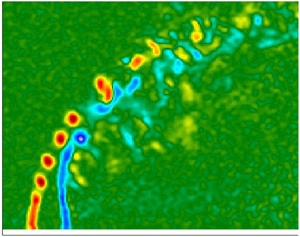Article contents
Effect of tabs on transverse jet instabilities, structure, vorticity dynamics and mixing
Published online by Cambridge University Press: 05 May 2021
Abstract

This experimental study examined the effects of strategic positioning of tabs in the periphery of the exit plane of a transverse jet as a means of controlling shear layer instabilities and vorticity as well as jet structure and mixing. Conditions corresponding to a naturally absolutely unstable upstream shear layer (USL), with low jet-to-crossflow momentum flux ratios  $J$ (below 8–9) and to a convectively unstable USL (
$J$ (below 8–9) and to a convectively unstable USL ( $J\geq 20$) were explored for different jet Reynolds numbers, 1900 and 2300. Acetone planar laser-induced fluorescence imaging and stereo particle image velocimetry were utilized to explore the influence of the tab. Placement of the tab in the upstream region of the jet exit caused significant weakening of the USL instability at lower
$J\geq 20$) were explored for different jet Reynolds numbers, 1900 and 2300. Acetone planar laser-induced fluorescence imaging and stereo particle image velocimetry were utilized to explore the influence of the tab. Placement of the tab in the upstream region of the jet exit caused significant weakening of the USL instability at lower  $J$, but with only marginal weakening for larger
$J$, but with only marginal weakening for larger  $J$ values. Yet tab placement was observed to affect cross-sectional structure and vorticity dynamics much more significantly at high
$J$ values. Yet tab placement was observed to affect cross-sectional structure and vorticity dynamics much more significantly at high  $J$ values. For all flow conditions, tab placement in the upstream region improved molecular mixing to a greater degree than at other locations. Vorticity fields, proper orthogonal decomposition modes, and coefficient plots extracted from centreplane velocity field measurements showed significant influence of tab placement on jet dynamical characteristics depending on
$J$ values. For all flow conditions, tab placement in the upstream region improved molecular mixing to a greater degree than at other locations. Vorticity fields, proper orthogonal decomposition modes, and coefficient plots extracted from centreplane velocity field measurements showed significant influence of tab placement on jet dynamical characteristics depending on  $J$. Tab locations with the greatest influence were consistent with wavemaker regions predicted in numerical simulations of the transverse jet (Regan & Mahesh, J. Fluid Mech., vol. 877, 2019, pp. 330–372), providing evidence for the potential to tailor shear layer rollup, jet structure and mixing via simple passive geometrical alterations.
$J$. Tab locations with the greatest influence were consistent with wavemaker regions predicted in numerical simulations of the transverse jet (Regan & Mahesh, J. Fluid Mech., vol. 877, 2019, pp. 330–372), providing evidence for the potential to tailor shear layer rollup, jet structure and mixing via simple passive geometrical alterations.
JFM classification
Information
- Type
- JFM Papers
- Information
- Copyright
- © The Author(s), 2021. Published by Cambridge University Press
References
REFERENCES
- 10
- Cited by


